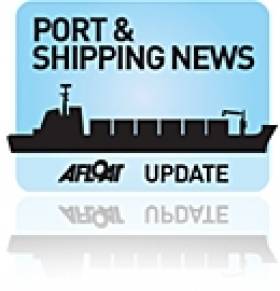Displaying items by tag: Irish Tourism Increase
IMDO Shipping Review – Irish Tourism Up, P3 Capacity Long-Haul Changes, EU Passes Ship Recycling and more
#Ports&Shipping –The latest IMDO Weekly Shipping Market Review includes the following stories as detailed below.
Irish Economy: Boost to Irish tourist numbers - The Irish economy has received a welcome boost as the number of trips by overseas residents increased by 7.8% between July and September compared to the same period last year. According to the Central Statistics Office, the figures which include tourists and people on business trips, increased by 164,300 trips in comparison to quarter three 2012 bringing the total to just over 2.2 million trips.
Container: P3 capacity on front-haul routes not set to change - Asia-Europe, Transatlantic and Transpacific capacity on the proposed P3 network will remain largely unchanged from the current service offers by Maersk, MSC & CMA CGM, according to Lloyd's List.
Based on analysis by Alphaliner, it is expected that while the frequency of most services will be marginally reduced, the deployment of lager -capacity vessels will result in average weekly TEU shipped on the three front-haul routes remaining the same.
Regulation: Ship recycling regulation passes EU Parliament -The European Parliament backed plans last week to end scrapping of EU-registered ships on third-country beaches, according to Fairplay. This measure will ensure vessels are recycled in EU-approved facilities worldwide, as opposed to the highly polluting practice of beaching.
For more on each of the above and other stories click the downloadable PDF IMDO Weekly Markets Review (Week 43). In addition to Afloat.ie dedicated Ports & Shipping News section.
IMDO Shipping Review: Irish Service Sector Growth, Capesize Rates High, Potential Eco-Ships Savings and much more
#Ports&Shipping –The latest IMDO Weekly Shipping Market Review includes the following stories as detailed below.
Irish Economy: Service sector growth - Fine summer weather, rising tourist numbers and continued signs of a growth saw Ireland's service sector grow at its fastest rate in 6 years in August.
The Investec Purchasing Managers' Index (PMI) measured services sector activity rise from 57.6 in July to 61.6 in August, the highest reading since February 2007 and well above the crucial 50 mark, which denotes that the activity level is expanding.
Bulker Market: Capesize Rates Hit High - The rates for the Capesize market have hit a year high of $19,811 as the Baltic Capesize Index surged 215 points to close at 2,660 last week. Backed by strong iron ore shipments from Brazil, Australia and South Africa into China, daily Capesize rates have risen by $1,957 since 4 September.
Container Market: Potential Savings of EcoShips - Eco designs for container ships could be the cost-saving future and make or break operators. A Hamburg conference has been told that a fuel-efficient design for a 9,000 TEU containership could save $2m a year, enabling it to reduce slot costs.
For more on each of the above and other stories click the downloadable PDF IMDO Weekly Markets Review (Week 36). In addition to Afloat.ie's dedicated Ports & Shipping News section.
























